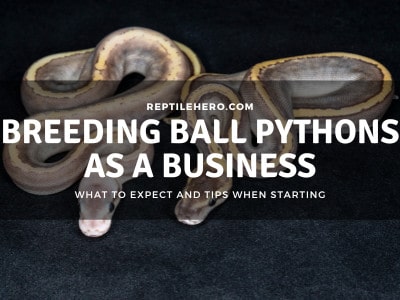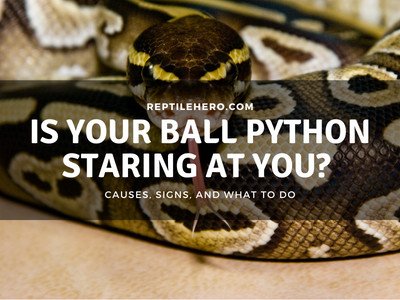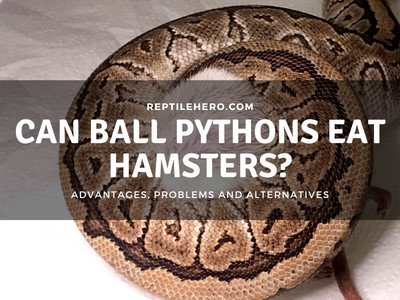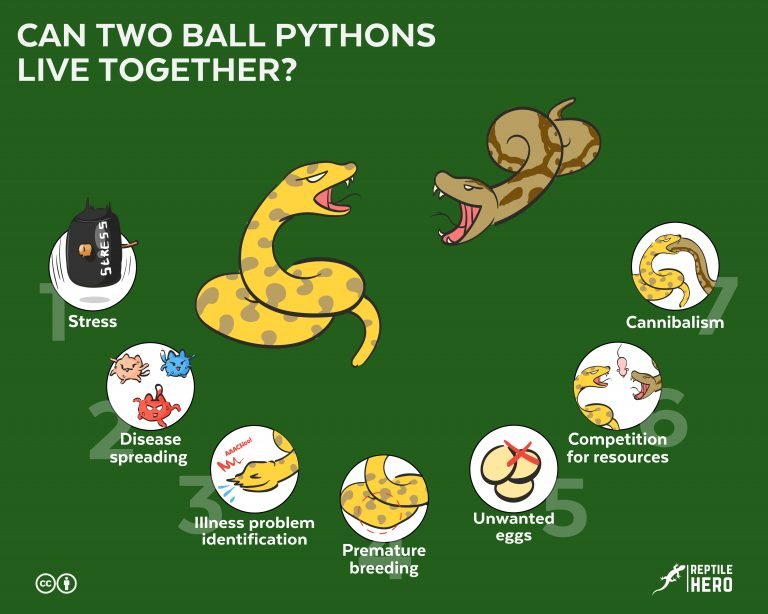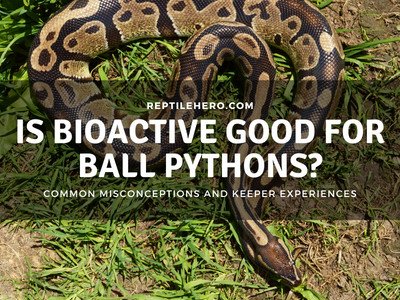Can You Use Tubs as a Ball Python Enclosure? What’s The Best Size?
Looking for an enclosure for your ball python while on a tight budget? Then you’ve probably considered using a huge plastic tub! The correct enclosure is one of the most debated parts of ball python care, so what can you use for your beloved pet?
In most cases, stand-alone tubs can be used as a ball python enclosure. The minimum size of the tub must be enough for the length of the snake on 2 sides. Tubs can work as a temporary enclosure. Glass, PVC, and wooden enclosures are still recommended for long-term use.
Ball pythons like tight spaces but they also need time and space for exploration. How can tubs accommodate a ball python’s basic needs? Why would you even use a tub instead of other alternatives? Stick until the end to know the answer to these questions and many more!
Do Ball Pythons Like Tubs?
Some keepers believe that ball pythons tend to like tubs due to their compact space and lesser exposure. However, experts only recommend the temporary use of tubs as ball python tanks due to the availability of better alternatives.
Keeping ball pythons in snake racks is one of the most debated topics in the community. But we should not mistake stand-alone tubs for snake racks as both have different setups.
Snake racks have typically smaller tubs with the purpose of saving space for the owners of multiple snakes. Meanwhile, stand-alone tubs have different sizes that can accommodate a ball python in a wide range.
Most snake racks also have a barren setup, with insufficient heating, lack of day/night cycle, low headroom, and no enrichment at all. We discourage setting up your ball python like this because we want to give our scaley pets the best life in our care.
Conversely, a ball python can live happily in an appropriately sized plastic tub with plenty of enrichment and hiding places.
No evidence suggests that ball pythons have a preference for tubs over tanks, and vice versa, as long as their needs are met. As a keeper though, it’s your responsibility to provide ball pythons with the best possible option—but more on that later.
5 Advantages of Using Tubs as a Ball Python Enclosure
Ball python keepers use plastic tub enclosures due to the following advantages: 1) affordability, 2) humidity control, 3) versatility, 4) lightness, and 5) ease of cleaning.
1. Affordability
One of the reasons why some ball python keepers opt to use plastic tubs is due to their affordable price. Plastic bins cost cheaper compared to glass, PVC, and wooden reptile enclosures.
The average cost of plastic tubs is around 15–50 dollars depending on the size. Compared to this, a glass enclosure can cost 30–70 dollars, while wooden and PVC ones will range from 80–500 dollars.
Plastic tubs are also relatively easy to get. Most supermarket and hardware stores will have plastic containers made for general storage. These are typically a great size for most ball pythons.
2. Humidity Control
In most cases, ball python keepers find that humidity is easy to maintain and control in a plastic tub. This is due to the ease of modifying the ventilation for a plastic tub.
Ball pythons need relatively high humidity, 60–70%. They also require localized humidity spots of up to 80% when they are about to shed.
In plastic tubs, you can drill small holes for ventilation. Then if the humidity drops, you can just cover some holes with tape or silicone.
Some screen-top enclosures can also be modified to hold more humidity but those require more work.
>>Learn more about humidity maintenance in our article about using foggers for ball pythons
Then again, some screen-top enclosures like this one from Zen Habitats come with removable humidity shields for less work!
3. Versatility
Using plastic tubs as a ball python enclosure will provide easier storage and stackability to maximize space. Modification on the tub itself can also be readily done using common tools found at home.
For modification, you can cut the part of a plastic tub’s lid and replace it with a metal mesh to accommodate a heat lamp/ deep heat projector.
Since ball pythons benefit from overhead lights, I don’t recommend stacking up plastic tubs directly on top of each other. Instead, you can safely stack tubs by building a shelf tall enough to place a heat lamp in.
You can also modify the plastic tub itself by replacing some sides with clear acrylic to have a better overall look. This is done by cutting some parts of the plastic tub to fit an acrylic panel which is then secured using hinges and finished with a secure lock.
In other places, there are many enclosure seller that convert large plastic bins to tanks with screen tops and acrylic sides. These are also considerably cheaper than other customized enclosures due to the materials used.
4. Lightness
Plastic tubs are lightweight in comparison to glass, PVC, and wooden enclosures of the same size. This means that transportation and general cleaning will be easier for ball python keepers
A large plastic tub can be moved around by a single person for easy cleaning since it’s lightweight.
By contrast, large enclosures made with heavier materials like wood often require at least 2 persons to move and clean due to the weight.
I can relate to this as I have a glass enclosure myself which is reinforced by aluminum strips. General cleaning is very hard to do because it is heavy and the glass may break if handled improperly.
5. Ease of Cleaning
Compared to glass tanks, plastic tub enclosures for ball pythons are relatively easier to clean. Even if the plastic tub fell, it would likely still be reusable. But minor chips and cracks are expected.
When cleaning an entire enclosure, plastic tubs are the easiest and are not that slippery compared to glass ones. It’s also less likely to have sharp edges which may become a hazard for you during cleaning.
If the plastic bin you use falls and cracks, especially during clean-ups it is relatively inexpensive to fix. It can also be easily replaced just by going to a store, unlike custom-made enclosures.
In addition to this, setting up a heavy glass enclosure by yourself can be a hard task. A little bit of a slip when putting it down can cause a crack on the glass which makes it unsafe for a ball python enclosure.
4 Problems of Using Tubs as a Ball Python Enclosure
There are 4 problems with using plastic tubs as ball python enclosures. More specifically, 1) heating, 2) security, 3) aesthetic, and 4) customization are greatly affected.
1. Heating
Since plastic can melt under continuous exposure to high heat, using overhead heat lamps in plastic tub enclosures can result in melting. Unless modified, plastic tubs can only accommodate under-tank heaters.
Polyethylene is the material used in most plastic tubs which have a melting point of around 120–140°F depending on the thickness. Overhead heaters can easily reach this temperature range in close contact.
Melted plastic can cause burns to the ball python. Gas fumes released from the melting plastic are also toxic for snakes.
Remember, under-tank heaters (UTH) do not produce infrared A and B. So the heat it emits can’t deeply penetrate a reptile’s body.
Conversely, overhead heaters like halogen and deep heat projectors (DHP) produce infrared A and B. So they are recommended for ball pythons.
2. Security
Most plastic bins open from the top, so a ball python can associate its keeper’s hands coming from above as a potential predator. This can make it feel threatened and become defensive.
Predatory birds are one of the main predators a ball python has in the wild.
Based on anecdotal evidence, some ball pythons don’t seem to tolerate being picked up directly above especially inside an enclosure.
You will appear as a big threat to their security if you pick them up from the top of their enclosure. In picking up a ball python, it is recommended to start from the back or belly.
3. Aesthetic
Some keepers refrain from using plastic tubs as a ball python enclosure due to its unappealing look. Most tubs don’t have clear sides which are not suitable for a display enclosure.
In addition to their translucent sides, most plastic tubs do not have a slick look, especially because of their lids.
This is purely a preference from the owner and would not affect the ball python at all if the setup is perfect.
Although some keepers assume that ball pythons are more comfortable in translucent and opaque enclosures like a plastic bin, this is not necessarily the case. This assumption comes from the fact that ball pythons are more reclusive during the daytime.
If you want a cleaner-looking enclosure, PVC and wood are great, but expensive alternatives.
4. Customization
Plastic tubs used as ball python enclosures have fixed sizes. Requests for a custom size cannot be accommodated by most manufacturers.
Although there is a wide range of sizes to choose from, you may find it hard to find a plastic bin that perfectly fits your setup. For this reason, made-to-order enclosures will be the best option in terms of customizability.
For custom-made enclosures, glass is the cheapest, wood is in the middle, then PVC is the most expensive of the three.
Factors to Consider When Choosing a Tub for Ball Pythons
When choosing a tub as an enclosure for your ball python, there are 3 things to keep in mind: 1) size, 2) material, 3) opacity, and 4) security.
1. Size
In enclosure size, it is important that the plastic tub enclosure can accommodate a fully stretched ball python. The height must also be enough for a ball python to climb onto something for enrichment.

The minimum size of the tub must be enough for the length of the snake on 2 sides. This means that if you have a 48-inch ball python, the sum of the length and width of the tub must be at least 48 inches as well (e.g., 36 x 12 inches).
Of course, this is just a minimum enclosure size but you can check the recommended enclosure-to-snake sizes in the table:
| Ball Python Size (Inches) | Minimum Enclosure Size (Inches, L-W-H) | Recommended Enclosure Size (Inches, L-W-H) |
| Hatchlings (12-14 inches) | 10 x 6 x 6 | 12 x 6 x 6 |
| Juveniles (24 inches) | 24 x 6 x 6 | 24 x 12 x 12 |
| Sub-adult (36 inches) | 24 x 12 x 12 | 36 x 12 x 12 |
| Adult Male/ Female (48 inches) | 36 x 24 x 12 | 48 x 24 x 24 |
| Large Adult Females (60-72 inches) | 48 x 24 x 24 | 60 x 24 x 24 |
Being fully stretched out is part of a ball python’s essential locomotor and static behaviors [2]. Smaller enclosures will not allow a ball python to stretch out as much as a bigger one which can lead to an unhealthy or obese snake.
The statement that “ball pythons like tight spaces” does not mean that their enclosure must also be small. They will enjoy a tight space in their hides but they must have an option to explore around the enclosure.
2. Material
Plastic bins generally have a few varieties like polyethylene, polyvinyl chloride (PVC), and polycarbonates. Of these options, PVC is the best for ball pythons because they have a high melting point whilst being sturdy and customizable.
All plastic tubs can release toxic fumes when it reaches a certain temperature. Melted plastic can also cause burns to a ball python.
The most common, polyethylene, releases toxic fumes at around 120-140°F. In comparison, PVC has higher temperature retention at around 150-160°F. However, polycarbonate plastic bins have the highest melting point at around 250°F.
Although polycarbonate seems like the best choice, we cannot find any manufacturers that sell such plastic bins that are big enough to house an adult ball python.
So the best plastic material, regardless of the price, is PVC. If you can find non-tub options, PVC enclosures can even be great for long-term housing.
3. Opacity
For light transmission, transparent and translucent plastic tubs are the recommended choice for ball python enclosures. On the contrary, fully opaque tubs are not recommended because they can disrupt a ball python’s day-and-night cycle.
Since ball pythons typically hide during the daytime, a translucent tub can work as long as there is a light source. A clear enclosure can also work as long as there are ample hiding places and clutter inside to make a python feel secure.
Some keepers suggest that translucent enclosures, which lets less light pass through, can be a comfortable environment for a ball python while allowing it to have a day/ night cycle.
Warning: I do not recommend using a completely opaque enclosure without some modifications. Even though ball pythons are generally crepuscular and nocturnal, light is also an important element to stimulate their day/night cycle.
For opaque tub modifications, make sure to replace the top and one side of the enclosure with a transparent or translucent material. You can do this by cutting the 2 sides then placing an acrylic panel and securing everything with ties, small bolts, or silicone.
4. Security
For ball python tubs, it is recommended to have a latching lock instead of a press-down lock. A large ball python can push open the lid especially if given enough leverage.
I experienced an escape from my ball python, Choco, when he was placed in a 12 x 6 x 6 inch plastic tub as his temporary enclosure. The tub itself has no latch which resulted in him powering through the lid.
For ball pythons measuring only 4 feet and below, I recommend this plastic tub on Amazon. It has a secure latching lock which a ball python cannot push upwards as long as it is secured properly. It also has a clean look to it with semi-transparent sides.
Setting Up a Plastic Tub Enclosure for Your Ball Python
When setting up a plastic tub enclosure for a ball python, it is important to take note of 1) ventilation, 2) provisions, and 3) heat.
Pro Tip: Plastic tubs with flat lids and sides are recommended over bins with ribbed lids and sides. It is easier to cut through bins with flat sides, which is great for conversions to accommodate heat lamps or acrylic panels.
1. Ventilation
For adequate ventilation in plastic bin enclosures for ball pythons, keepers need to drill holes or install a ventilation mesh. The holes can be drilled using a drill or a soldering iron.
Fun Fact: Ball pythons live in areas like burrows that may have limited airflow. They can thrive in low-oxygen environments without suffocating.
There is no rule on the specific number of holes for proper ventilation. It will also vary depending on the size of the tub itself.
I recommend starting out with at least 2 rows of breathing holes on all sides and on the lid of the ball python bin.
Remember that it is fine to over-ventilate a plastic tub enclosure, as it can be modified by simply covering some holes with some silicone or tape.
So if you notice that the humidity inside the tub enclosure is dropping, I suggest covering up 50% of the holes you made and observing the humidity levels for a couple of days.
Then you can make more adjustments depending on the changes in humidity levels.
2. Provisions
For the provisions of a ball python’s tub enclosure, it is important to have the following: 1) hides, 2) water bowl, 3) substrate, and 4) clutter.
1. Hides
For any ball python enclosure, there should be at least 2 hides provided. One for the cold side and one for the warm side.
The hide itself should be able to fit the ball python snugly and have no sharp edges to avoid scale damages and other injuries.
2. Water Bowl
There should be at least one water bowl for the tub enclosure and it must be big enough to let the snake soak in it.
It should also be somewhat shallow (2–3 inches high) to minimize the risk of drowning. It is also recommended to place it in the middle of the enclosure.
3. Substrate
The substrate will vary depending on the local climate. If you need more moisture, go for substrates like coco fiber, coco husks, and cypress mulch.
For those in a more humid environment, I recommend using dust-free or pet-safe aspen shavings. The depth of the substrate should be at least 2–3 inches.
4. Clutter
Providing clutter in a ball python enclosure can be enriching for the snake and provide more hiding spots. Cork barks, branches, and fake plants are some common choices.
Before placing any clutter inside the enclosure I recommend disinfecting it to avoid mold/ bacterial growth inside the bin. You can boil or bake the wooden items while fake plants and ornaments can be cleaned using dish soap.
3. Heat
Heating elements like under-tank heaters and heat lamps can work as heat sources for tub enclosures. It’s important to note, however, that some modification to the plastic bin is required before keepers can use it with overhead heaters.
To accommodate a heat lamp in a plastic tub enclosure, here is the procedure:
- Cut out a circle half an inch wider than the circumference of the heat lamp itself. Use a cutter for thin lids and soldering iron for thicker ones.
- You can use a pizza screen, simple aluminum mesh, or any other sturdy metal barrier to cover the hole on the lid. These must be cut larger than the hole.
- Drill or melt 8–10 holes around the hole that you made initially.
- Secure the screen with small zip ties or steel wires then trim the excess.
- Finally, cover the edges of the circle with silicone to prevent injuries to the ball python.
Pro Tip: If you are going to use a heat lamp for a plastic bin, make sure that the height of the tub itself is at least 12 inches or higher. This will lessen the risk of melting the plastic and burns on the ball python.
Further Questions
Are tubs or tanks better for ball pythons?
As a ball python enclosure, both tubs and tanks can suit the snake depending on its setup. Although tanks can suit a ball python for the long term due to their larger sizes and heating accommodation. Better alternatives can be PVC and wooden enclosures.
How long can ball pythons live in a barren enclosure?
Ball pythons are very hardy animals and can live in a barren enclosure (only a water dish and a hide) for all their life, as shown by breeders. But this does not mean that they only “need” minimum care in order to thrive in captivity. Moreover, ball pythons in barren enclosures are likely to experience boredom and lack mental stimulation.
Summary of Using Tubs as a Ball Python Enclosure
In general, tubs can be used as temporary ball python enclosures as long as their needs are met in the setup. Tubs can be a great alternative due to their cheap price, humidity retention, versatility, lightness, and durability.
Tubs are not recommended by other keepers due to heating compatibility, security issues, unaesthetic look, and the lack of size customization. To choose the best tub, it is important to take into consideration its size, material, opacity, and security.
When setting up a plastic tub enclosure for a ball python, it is important to have ventilation, provisions, and heat sources. An enclosure must contain at least two hides, one water dish, substrate, and clutter.
Sources
[3] https://www.researchgate.net/publication/31442824_Blood_Oxygen_Transport_and_Delivery_in_Reptiles

